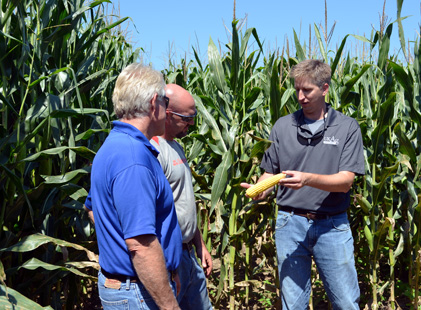UK research explores irrigation questions
UK research explores irrigation questions

Interest in irrigation is gaining momentum among Kentucky grain farmers. This is especially true after another prolonged dry spell during a crucial corn growth stage in Western Kentucky squashed many hopes for a bin-busting year. Agronomists with the University of Kentucky continue to research ways to provide added moisture for the soil.
Chad Lee, agronomist with the UK College of Agriculture, Food and Environment, is in the second year of an irrigation study with farmers across the state. While the initial research in 2013 took place around Owensboro and Henderson, the study moved east this year with cooperating farmers in Hardin and Boone counties and with a plot at UK’s Spindletop Research Farm in Lexington.
Irrigated acres have doubled in the past five years in Kentucky but still remain under 10 percent of the state’s total acreage. Lee’s 2014 study, funded by the Kentucky Corn Promotion Council and industry, focuses on corn’s response to irrigation, high seeding rates and different nitrogen rates. The ultimate goal is to find the most efficient and cost effective way for the state’s farmers to achieve better yields. UK graduate student Julie Baniszewski and undergraduate Lauren Settles are working with Lee on this study.
“One of our biggest limitations when it comes to higher (corn) populations is water,” Lee said. “If we have water to put on a field, then we can push corn populations higher and possibly get better yields.”
Hardin County farmer Bob Wade Jr. saw the value in irrigation and installed his first center pivots in fall 2011, right before the disastrous growing season of 2012. About 25 percent of his corn and soybeans are irrigated.
“The decision to invest in irrigation came about because of the high corn prices and the increase in land values and cash rental rates,” he said. “We were trying to figure out a way to add value to our existing ground versus buying or renting more land.”
While higher seeding rates seem like a logical way to boost yields, they may not always work in the farmers’ favor. Higher populations create a denser plant canopy, which favors disease development. It can also result in smaller stalks that are more prone to lodging.
Irrigation is not an option for every Kentucky farmer, as many lack water sources near their farmland. Those who do have access to water, however, may see the benefits of it, especially during hot, dry summers.
David Brannon is a crop scout for Wade and other farmers in the county. He’s noticed a big difference between irrigated and non-irrigated crops this year.
“You see such a tremendous response with irrigation,” he said. “A lot of times when Bob is making decisions about applying a fungicide or adding more units of nitrogen, he hopes to see a response from his investment that’s greater than the cost. With irrigation, especially in a year like this or in 2012, the responses are phenomenal.”
While this research is aimed at helping Kentucky farmers improve their efficiency and bottom lines, it could have worldwide impacts.
“If we look 10 to 20 years down the road, we will have to figure out how we can continue to feed the world on our existing acreage,” Lee said. “Irrigation is going to become more important in that overall concept of feeding people more efficiently and more sustainably.”
Extension Research Weather

